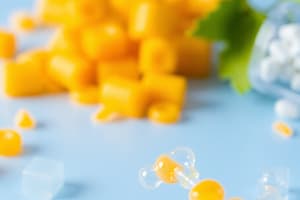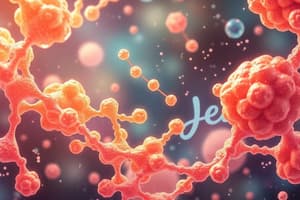Podcast
Questions and Answers
Which of the following statements about oligosaccharides is NOT true?
Which of the following statements about oligosaccharides is NOT true?
- They produce gaseous products when broken down by intestinal bacteria in humans.
- They are typically found in onions, cabbage, broccoli, and wheat.
- They are typically sweet and taste good. (correct)
- They are composed of a short chain of monosaccharides linked together.
Which of these is NOT a common type of polysaccharide?
Which of these is NOT a common type of polysaccharide?
- Lactose (correct)
- Chitin
- Dextran
- Starch
Which type of polysaccharide is responsible for the structural integrity of plants?
Which type of polysaccharide is responsible for the structural integrity of plants?
- Glycogen
- Starch
- Chitin
- Cellulose (correct)
Which of the following oligosaccharides is NOT related to a bitter taste?
Which of the following oligosaccharides is NOT related to a bitter taste?
What is the main difference between homopolysaccharides and heteropolysaccharides?
What is the main difference between homopolysaccharides and heteropolysaccharides?
Which of the following pairs correctly matches a polysaccharide with its function?
Which of the following pairs correctly matches a polysaccharide with its function?
Which of the following is a characteristic of disaccharides?
Which of the following is a characteristic of disaccharides?
Which of the following statements correctly compares fructose and sucrose?
Which of the following statements correctly compares fructose and sucrose?
Which of the following statements about oligosaccharides is FALSE?
Which of the following statements about oligosaccharides is FALSE?
Which of the following is NOT a derived carbohydrate?
Which of the following is NOT a derived carbohydrate?
What is the structural feature that distinguishes aldehydes from ketones?
What is the structural feature that distinguishes aldehydes from ketones?
Which of the following is a true statement about monosaccharides?
Which of the following is a true statement about monosaccharides?
Which of the following correctly describes the relationship between disaccharides and monosaccharides?
Which of the following correctly describes the relationship between disaccharides and monosaccharides?
What type of bond is responsible for linking monosaccharide units together to form larger carbohydrate structures?
What type of bond is responsible for linking monosaccharide units together to form larger carbohydrate structures?
Which of the following carbohydrates is classified as a trisaccharide?
Which of the following carbohydrates is classified as a trisaccharide?
What is the primary function of glycogen in the human body?
What is the primary function of glycogen in the human body?
What is the most abundant organic molecule found on Earth?
What is the most abundant organic molecule found on Earth?
Which of the following statements correctly describes monosaccharides?
Which of the following statements correctly describes monosaccharides?
In the context of carbohydrate classification, which characteristic applies specifically to disaccharides?
In the context of carbohydrate classification, which characteristic applies specifically to disaccharides?
Which carbohydrate structure primarily serves as a supportive structural component in plants?
Which carbohydrate structure primarily serves as a supportive structural component in plants?
Which statement is true regarding the energy stored in carbohydrates?
Which statement is true regarding the energy stored in carbohydrates?
What is the general chemical formula for carbohydrates represented by the formula CnH2nOn?
What is the general chemical formula for carbohydrates represented by the formula CnH2nOn?
Which monosaccharide is specifically classified as a ketotriose?
Which monosaccharide is specifically classified as a ketotriose?
What is the primary physiological significance of D-(+)-mannose in the human body?
What is the primary physiological significance of D-(+)-mannose in the human body?
Which statement correctly describes the classification of monosaccharides based on their stereochemistry?
Which statement correctly describes the classification of monosaccharides based on their stereochemistry?
Which of the following is classified as an aldohexose?
Which of the following is classified as an aldohexose?
Which carbohydrate is the final form into which all carbohydrates are degraded in the body?
Which carbohydrate is the final form into which all carbohydrates are degraded in the body?
Which pentose sugar is important as a building block of RNA and DNA?
Which pentose sugar is important as a building block of RNA and DNA?
Which of the following describes the spatial arrangement of an aldotriose?
Which of the following describes the spatial arrangement of an aldotriose?
What defines a ketohexose among monosaccharides?
What defines a ketohexose among monosaccharides?
Which of the following is NOT a ketopentose?
Which of the following is NOT a ketopentose?
Which carbohydrate is known for being used in hospitals as an intravenous source of nourishment?
Which carbohydrate is known for being used in hospitals as an intravenous source of nourishment?
Flashcards
Carbohydrates
Carbohydrates
The most abundant class of bioorganic molecules, mainly sugars, storing chemical energy.
Monosaccharides
Monosaccharides
Simple sugars that are basic building blocks of carbohydrates, containing one sugar unit.
Glucose
Glucose
A simple sugar that serves as a primary energy source and part of larger carbohydrates.
Starch
Starch
Signup and view all the flashcards
Cellulose
Cellulose
Signup and view all the flashcards
Fructose
Fructose
Signup and view all the flashcards
Oligosaccharides
Oligosaccharides
Signup and view all the flashcards
Solanin
Solanin
Signup and view all the flashcards
Glycosidic linkages
Glycosidic linkages
Signup and view all the flashcards
Polysaccharides
Polysaccharides
Signup and view all the flashcards
Homopolysaccharides
Homopolysaccharides
Signup and view all the flashcards
Heteropolysaccharides
Heteropolysaccharides
Signup and view all the flashcards
Storage polysaccharides
Storage polysaccharides
Signup and view all the flashcards
Disaccharides
Disaccharides
Signup and view all the flashcards
Hydrolysis of Disaccharides
Hydrolysis of Disaccharides
Signup and view all the flashcards
Carbonyl Group
Carbonyl Group
Signup and view all the flashcards
Derived Carbohydrates
Derived Carbohydrates
Signup and view all the flashcards
Sugar Acids and Alcohols
Sugar Acids and Alcohols
Signup and view all the flashcards
Hexoses
Hexoses
Signup and view all the flashcards
D-mannose
D-mannose
Signup and view all the flashcards
D-galactose
D-galactose
Signup and view all the flashcards
D-(-)-ribose
D-(-)-ribose
Signup and view all the flashcards
D-(-)-glyceraldehyde
D-(-)-glyceraldehyde
Signup and view all the flashcards
Dihydroxyacetone
Dihydroxyacetone
Signup and view all the flashcards
Spatial orientation (stereochemistry)
Spatial orientation (stereochemistry)
Signup and view all the flashcards
Study Notes
Carbohydrates - Structure and Function
- Carbohydrates are the most abundant class of bioorganic molecules on Earth, produced by photosynthesis in green plants.
- They are also known as saccharides due to the sweet taste of many.
- Carbohydrates store chemical energy (glucose, starch, glycogen)
- One gram of digested carbohydrate yields approximately 4 kcal of energy.
- Complex carbohydrates are beneficial for a diet.
- Carbohydrates are supportive structural components in plants and some animals (e.g., cellulose, chitin).
- Carbohydrates form part of the structural framework of DNA and RNA.
- Carbohydrate markers on cell surfaces are crucial for cell-cell recognition.
Classification of Carbohydrates
- Carbohydrates have the general formula (C_n(H_2O)_n).
- (n) varies from 3 to 8.
- They are classified based on the number of carbon atoms (triose, tetrose, pentose, hexose, heptose, octose).
- They can be further classified as aldoses (aldehyde group) or ketoses (ketone group)
- Monosaccharides are simple sugars, containing a single polyhydroxy aldehyde or ketone unit that can't be broken down further through hydrolysis.
- Disaccharides contain two monosaccharide units covalently bonded, crystallizing as water-soluble solids.
- Disaccharides produce monosaccharides upon hydrolysis.
- Oligosaccharides contain 3-10 monosaccharides units, and disaccharides are the common type.
- Polysaccharides contain tens of thousands of monosaccharides units.
- Homopolysaccharides are polymers of a single monosaccharide (e.g., glycogen, cellulose, starch).
- Heteropolysaccharides contain multiple different monosaccharides types (e.g., hyaluronic acid, heparin, chondroitin sulfate).
- Derived carbohydrates have gone through chemical reactions to form other products, such as sugar acids, sugar alcohols, deoxysugars, and sugar amines.
Carbonyl Group
- A carbonyl group is a chemically organic functional group, consisting of a carbon atom double-bonded to an oxygen atom.
- The two simplest examples of these are aldehydes and ketones.
- Aldehydes and ketones are usually attached to another carbon compound.
Monosaccharides
- These are simple sugars with the general formula (C_nH_{2n}O_n), where n can range from 3 to 8.
- Different numbers of carbons determine trioses, tetroses, pentoses, hexoses, heptoses, and octoses.
- An aldose has an aldehyde group, and a ketose has a ketone group.
Biochemically Important Monosaccharides
- Glucose, fructose, galactose, and ribose are crucial for various biological processes.
- Glucose is the most abundant monosaccharide found in nature and is also a key component of blood sugar.
- Fructose is the sweetest of common sugars, found in fruits and honey.
- Galactose is a component of milk sugar.
- Ribose is a part of RNA and DNA.
- D-Mannose is found in certain bacteria, fungi, and plants.
- D-glucose is used in hospitals as an intravenous source for nutrition.
Cyclic Forms of Monosaccharides
- Hemiacetals and hemiketals are formed from the reaction between aldehyde or ketone and alcohol.
- Cyclic hemiacetals/hemiketals exist widely in nature and are five-or six-membered rings.
- There is an a- and β-form for these.
- Mutarotation is the interconversion between the cyclic forms, (α-and β) of sugars, accompanied by a change in specific rotation. Only sugars that form hemiacetals or hemiketals exhibit this property.
Disaccharides
- Two monosaccharides are linked by an acetal formation reaction to form a disaccharide.
- The bond formed is called a glycosidic bond.
- Common examples of disaccharides include maltose, lactose, and sucrose.
- Maltose consists of two glucose units connected by an α(1 → 4) glycosidic linkage.
- Lactose consists of β-galactose and β-glucose linked by a β(1 → 4) glycosidic bond.
- Sucrose consists of an α-glucose and a β-fructose linked by an α(1 → 2) glycosidic linkage.
Oligosaccharides
- Oligosaccharides are carbohydrates containing between three and ten monosaccharides.
- Common examples include raffinose and stachyose, found in beans.
Polysaccharides
- Polysaccharides are macromolecules comprised of many monosaccharides joined by glycosidic linkages.
- Starch is a storage polysaccharide in plants, composed of amylose and amylopectin.
- Glycogen is an animal storage polysaccharide.
- Cellulose is a structural polysaccharide in plants, composed of linear chains of β-glucose units connected by β(1,4) glycosidic linkages.
- Chitin is a structural polysaccharide found in the exoskeletons of insects, crabs, and other arthropods.
Acidic Polysaccharides
- These have acidic groups and important biological functions.
- Hyaluronic acid is found in the vitreous humor, along joint fluid.
- Chondroitin sulfate plays a crucial structural role in cartilage, bone, and the cornea.
- Heparin is an anticoagulant, preventing blood clot formation.
- Alginic acid has a variety of applications, especially in food products.
Dietary Considerations
- The glycemic index (GI) measures how quickly dietary carbohydrates are digested and affect blood glucose levels.
- Low-GI foods are preferable for better blood sugar control.
- Unavailable carbohydrates, known as dietary fiber, are not digested by human enzymes.
- Fiber aids digestion and can ease bowel movements.
- Insufficient fiber consumption can affect digestive health.
Studying That Suits You
Use AI to generate personalized quizzes and flashcards to suit your learning preferences.




